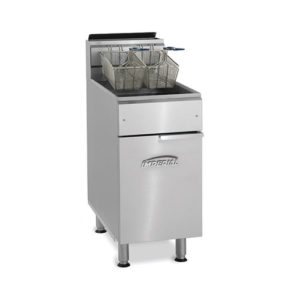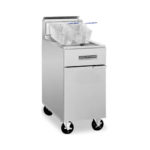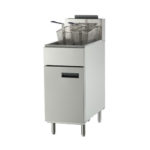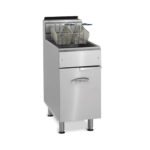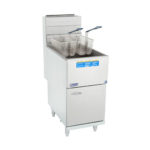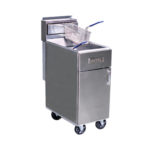07 Jan, 2017
Buying Guide | Commercial Fryer
Commercial Fryers deliver products and profitability from various food items and will always be vital in a commercial kitchen. It does one thing but could deliver substantial contribution to your revenues. From garnishes to potatoes to meats to seafood and fish, this uni-tasker will deliver any time of the day. The fries in the sandwich combo is a great way to make this point. Every time a combo is ordered the Fryer delivers revenues.
Steaks do not sit well in a Commercial Deep Fryer and when the chef does this the cooks will for sure step out of the kitchen because they do not want to have anything to do with this failure!
The right fryer suits the right restaurant product lines and their customers.
Gas and Electric
The decision to go with gas or electric is driven by a few factors. Energy costs will be a major consideration on your expenses. Your existing fryer’s hook up connections will change when you change from gas to Electric fryer or vice versa. Gas fryers tend to be less expensive to operate.
- Countertop Fryers – Countertop Fryer is a good option if space is limited and tend to be cheaper than floor models.
- Floor Fryers – A heavy duty flexible option. Occupies more space but will allow a wide variety of food and larger volume.
- Built-in Filtration System – Typically Oil Filtration System are floor types and will extend the life of your oil. The filtration system translates into savings on oil and labor.
- Split Pot – Frying different types of food simultaneously. Food tend to have varying flavors especially if it is not coated or breaded and it affects the oil in the tank.
Types of Gas Fryers
Tube Fryers
- Tube Fryers are equipped with vertical burners.
- These vertical burners are suitable for large volume frying with a wide variety of food.
- The sediment zone is below the burners and tends to be bigger.
- These fryers are versatile.
Open Pot Fryers
- Open Pot Fryers are equipped with horizontal burners.
- These burners are suitable for frying with smaller volume.
- These fryers tend to have a smaller sediment zone.
- Cleaning is easy and the staff will be happy about this.
Flat Bottom Fryers
- Flat Bottom Fryers tend to be more specific with type of food and volume you will use it for.
- It is more suitable for food that will not discharge sediment because it has no sediment zone.
- Food particles that will be discharged from the food will tend to burn and flavor will be transferred to food.
- These fryers tend to be difficult to clean.
Tank Capacity
The amount of food you can produce on your Deep Fat Fryer is normally determined by the tank of your deep fryer. A busy place will be required to produce deep fried items more reliably with uniform quality. Choosing the tank capacity will depend on the number of seats and turnover of customers ordering deep fried food on the menu. You will have to include drive through and take outs.
Temperature
Controlling temperatures is critical for your Deep Fat Fryer because it could burn the food or absorb more oil resulting in a soggy fry.
- Recovery Time – is critical every time you put food at room or cold temp in the fryer. Temperature will go down.
- Heat Distribution – various types of fryers will vary with the design of the burners. We want the heat distribution to be as even as possible in the oil that is critical to frying. The fryer should be able to work with a wide range of temperature that is critical to varying types of food.
- Sediment Area – part of the tank where food particles are gathered should have a relatively cooler temperature to prevent a burnt flavor on food. This part of the tank could not be seen or reached with hot oil in the tank.
Cleaning
Cleaning Commercial Fryers should not be difficult considering that you are dealing with a tank of hot oil. Putting two chinois with a filter in between on a metal bucket should do the trick. As you drain the oil from the tank it is getting filtered on 3 layers. You can then re-use the oil but eventually will have to replace it. Over time oil will breakdown and will affect cooking temperatures. There are fryers with a built-in filtration system.
Safety
Safety of these equipment seem straightforward. Using casters on the equipment will allow easy maneuverability. As they say “the harder the equipment is to move the more chances it will not get a deep clean”. Try putting casters on a lighter fryer like a one basket fryer then it becomes a hazard because it will be more stable on legs.
Water and oil do not mix since the time of Adam and Eve and still is the case. Commercial Fryers should not be placed near sinks and faucets and should be used with caution on food containing huge amounts of water. Remember that ice becomes water.
The right equipment tubes and valves will be critical for connections. Timers and full attention is a requirement because the food could easily burn.
Durability
Durability is critical in a commercial kitchen. There is a big difference between commercial and domestic grade equipment even if they look the same on the exterior. The main components of a fryer should be made of durable materials that is resistant to high temp all day and the surfaces finished for easy cleaning and to prevent scratching.
Normally, the head chef and the business owners will be aware of the cost of the equipment and its value to the business because they think along the lines of business. The cooks and the employees think along the lines of getting the food out to the customer in superb fashion quickly. The equipment will most likely get beat up as the kitchen gets busier and at times frantic.
Common Commercial Fryer
|
|
|
|
|
Imperial |
|
Pitco |
<li”>Cabinet – stainless front, door and sides.
|
Royal |
|

